Herbicide Options for Mixed Pine-Hardwood Management
Forest ownership is often motivated by a variety of factors. While many landowners cite timber production as an important reason for owning forestland, many of these same landowners are also interested in enhancing recreational experiences or maintaining the family forest legacy.
While many ownership goals are at least somewhat compatible with traditional forms of intensive timber management, balancing multiple objectives can sometimes be difficult. Consequently, a growing number of forest landowners are interested in exploring alternative forms of pine forest management. Although pine plantation management has been historically employed to maximize economic returns, managing mixed pine-hardwood stands may serve some landowners with multiple management goals.
A mixed pine-hardwood stand is a forest stand comprised of a species mixture where both pine and hardwood species are represented as significant components of the overall stand. Due to their greater functional and structural diversity, mixed pine-hardwood stands have several inherent advantages compared to pine plantations. For example, mixed pine-hardwood stands can provide higher quality habitat for wildlife because they produce more desirable mast and have greater structural diversity.
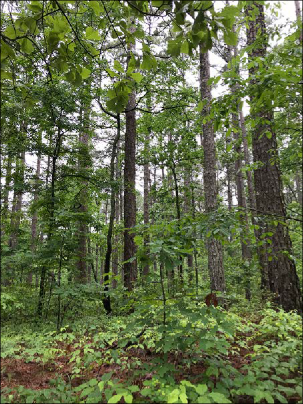
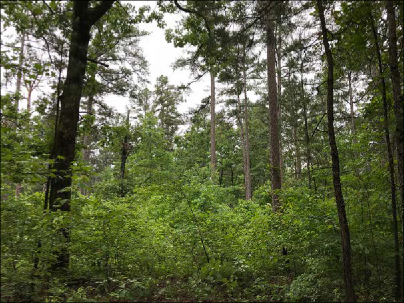
Mixed pine-hardwood stands are also valued for timber production, as both hardwood and pine sawtimber can be produced within the same stand. Growing a diversity of sawtimber products may be desirable to landowners concerned with economic and environmental risks.
An additional benefit of mixed pine-hardwood stand management is that these stands can be attained through natural regeneration. In Mississippi, mixed pine-hardwood stands typically develop in a two-aged structure, with stems of younger hardwood species establishing beneath an older pine overstory. Another scenario where these stands might be established is as an even-aged stand following some form of natural disturbance (e.g., hurricanes, tornadoes, insect outbreaks).
While obtaining a mixed pine-hardwood stand under some circumstances may be relatively easy, it is important to recognize that obtaining and maintaining desirable trees in the specified species mixture may require silvicultural intervention. This is particularly true if maintaining timber value is an important management objective, as less valuable, shade-tolerant species will eventually gain dominance in the absence of disturbance.
Forest landowners have access to several tools for controlling species composition in these stands. However, in many situations, the cheapest, quickest, and most effective option for obtaining and maintaining a desirable pine-hardwood mixture may be using herbicides.
This publication describes herbicide options available to forest managers interested in the establishment and maintenance of mixed pine-hardwood stands. Careful attention is warranted when considering application rates and timing because forest herbicides can damage these stands if applied improperly. While herbicidal treatment of pine stands is relatively straightforward, achieving competition control in pine-hardwood mixtures is a more complicated process compared to pure pine stands.
This publication is not intended to be an all-encompassing listing of treatment options. We have reviewed only the more commonly used product names, rates, and application timings with proven worth in both operational forest herbicide work and research. As with any application of forest herbicides, you should consult your local MSU Extension agent, Extension forestry specialist, or consulting forester before using the information found in this publication if you are not familiar with the products detailed and their effects in mixed pine-hardwood stands.
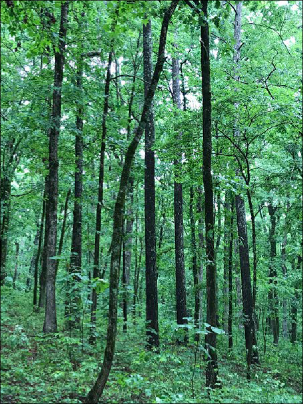
The information given here is for educational purposes only. References to commercial products or trade names are given with the understanding that no endorsement by Mississippi State University Extension is implied and that no discrimination is intended against other products or suppliers that may also be suitable and have label clearance.
Chemical Site Preparation
Natural regeneration is often used to regenerate mixed pine-hardwood stands. Greater diversity of tree species in the final mixture motivates many managers to use available natural seed sources and advance regeneration to minimize establishment costs. Including hardwoods in these mixtures makes chemical site preparation unnecessary. Subsequently, chemical site preparation would not commonly be employed in natural regeneration efforts.
However, there is increasing interest in establishing mixed pine-hardwood stands where they did not exist before, where consideration for regeneration was not given before harvesting, or where on-site species are undesirable for management goals. In these situations, artificial regeneration is the only option, and chemical site preparation is an invaluable tool.
Chemical site preparation involves applying herbicides in an attempt to control competing vegetation before plantng. Crop trees have not been planted and are not a concern at this point. Consequently, you have greater flexibility in herbicide choice. In addition, higher rates of herbicides are labeled for site-preparation applications compared to those used once seedlings are planted. These higher rates may be necessary to control more inherently resistant species or species that have developed resistance to appropriate herbicides in former agricultural areas.
Pine and hardwood silviculture differ, but both systems benefit from proper competition control. While post-planting herbicide options differ greatly between pine and hardwood systems, chemical site preparation treatments are similar. Applications using imazapyr (e.g., Arsenal AC, Chopper GEN2, and others) and glyphosate (e.g., Accord Concentrate, Accord XRT II, and others) are the most commonly used compounds on cutover sites.
While both of these herbicides are used for hardwood control in pine site preparation, visible herbicide damage has not been noted on planted hardwood seedlings when commonly prescribed rates are used and applications occur at least three months before planting. In addition, if the planting site has sandy, loamy sand, or sandy loam textures and is moderately well or well to excessively well drained, or has organic matter content of greater than 2 percent, an additional month should be added between herbicide application and planting. Currently, the standard chemical site preparation recommendation for mixed pine-hardwood plantings is:
28–32 oz/acre Chopper GEN2 + 4–5 qt/acre of a forestry-labeled glyphosate product + surfactant (nonionic at 0.5% vol/vol or methylated seed oil (MSO) at 1% vol/vol)
Detail (saflufenacil) may be added to this mix at a 2 oz/acre rate to increase natural pine control.
The site preparation treatment above is intended for general use and is appropriate when non-waxy-leafed species make up the onsite species mix. In situations where waxy-leafed species (e.g., wax myrtle, yaupon, gallberry) make up a significant portion of the targeted species mix, a tricloypr product should be used in lieu of glyphosate in the tank mixture. The most common site preparation prescription for areas with waxy-leafed species is:
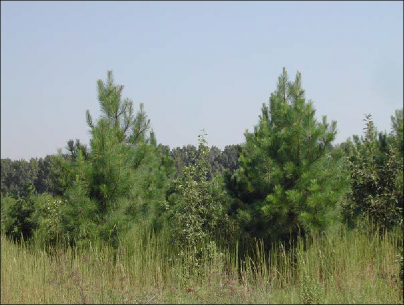
32–48 oz/acre Chopper GEN2 + 1–1.5 qt/acre Garlon 4 + MSO (2.5% vol/vol late spring/summer or 1–1.5% vol/vol for August or later applications)
Both applications detailed above should occur from August to October before planting. If planting is to occur early in the planting year (November to December), pay special attention to the amount of time between application and planting in the hardwood component. Earlier applications may not adequately reduce vegetative competition due to natural encroachment of these species over time.
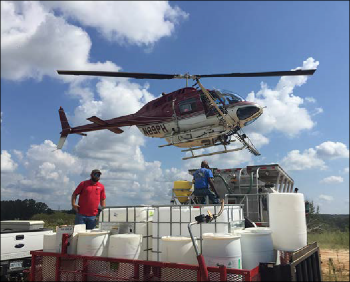
Herbaceous Weed Control (HWC)
When properly applied, chemical site preparation provides excellent control of vegetation existing at the time of application. However, these applications will not typically provide lasting control of herbaceous competition after planting unless a product with sufficient residual soil activity is added to the mixture. Herbaceous competition will germinate from onsite seeds and encroach from offsite sources.
HWC involves use of herbicides designed to control these herbaceous competitors during the first growing season after planting. There are several products labeled for HWC in pine plantations. However, most of these treatment options are of limited use in mixed pine-hardwood planting efforts due to the susceptibility of hardwood species to the active ingredients in some of these herbicides.
The HWC herbicide intended for use in mixed pine-hardwood stands is often included as part of the site preparation tank mixture in a quantity sufficient to have a residual effect into the next growing season. The typical HWC addition to a mixed pine-hardwood site preparation application is as follows:
3 oz/acre Oust XP
Consideration should be given to soil pH. See label.
If growing-season HWC was not included
in the tank mix for site preparation, two “stand-alone” options are available. These applications should
occur soon after planting from January through early March. These herbicides can damage hardwood
species if applied after bud break. Consequently, treatment should strictly follow the label rate and application timing. Applied as a pre-emergent, Oust XP (sulfometuron methyl) provides excellent control of most grass and broadleaf competitors. Goal 2XL (oxyfluorfen) will provide good control of some grasses and many broadleaf species, but overall efficacy will be lower than that of Oust XP. Application rates are as follows:
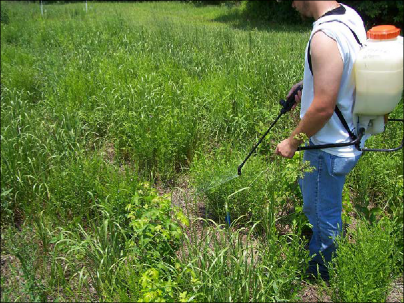
2 oz/acre Oust XP
Consideration should be given to soil pH. See label.
64 oz/acre Goal 2XL
Occasionally situations arise where grasses are the predominant form of herbaceous competition or HWC applications were not possible before hardwood leaf emergence. If HWC is warranted under one of these situations, a grass-only herbicide for HWC is the only choice available. Two products labeled for grass control in hardwoods are Select 2EC (clethodim) and Fusilade DX (fluazifop-P-butyl). Both herbicides are foliar-active and effective only on grass species.
These two herbicides offer the best option for control of “problem” grasses such as bermudagrass or johnsongrass; Select is generally more effective in single application treatments. Nonionic surfactants should be used with either of these products. Spray rates and application timings vary depending on growth stage and target species. Consult the label.
Different herbicides have different lengths of vegetative control when applied on targeted vegetation. None of the herbicides used in HWC will provide complete control of vegetation for an entire growing season. The intent of these applications is not to achieve complete growing-season herbaceous control, but rather to provide an adequate time for seedlings to establish in a “free-to-grow” status.
Timber Stand Improvement (TSI)
Release and mid-rotation brush control (MRBC) applications are effective options for post-planting herbicide treatments in pine plantation management. However, use of these treatments is severely limited in mixed pine-hardwood stand management. Managers wishing to perform TSI work in mixed pine-hardwood stands have to perform individual stem treatments. While mechanical techniques are available (e.g., sawing), costs are typically prohibitive. TSI in mixed pine-hardwood stands is usually performed using herbicide injection, basal bark treatments, or directed spray applications.
Injection
Injection is an effective means to control stems of undesirable quality or species, or for overall density reduction. Multiple compounds have been tested and are labeled for injection. Historically, much injection work was performed through girdling trees using frill cuts and “painting” a solution of Tordon (picloram) into the cut. Tordon products worked well in this capacity, but problems with nontarget species impact were very common. Arsenal AC has become the standard for injection of hardwoods because it has a wide spectrum of effectiveness in woody species. Avoid ground contact with imazapyr; soil activity could result in nontarget impact of hardwoods. Current injection recommendations for hardwood species are:
Arsenal AC mixed at 20% vol/vol with water
Apply 1 ml of solution per cut and use 1 cut per 3 inches of stem diameter.
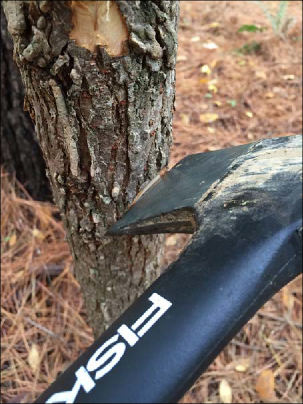
Imazapyr will not provide sufficient levels of pine stem control. Other herbicides are available for use in these applications. Increased numbers of injection points and greater herbicide concentrations result in higher application costs in pines. The two recommended injection applications for pine are:
Garlon 3A mixed at 33% vol/vol with water
Apply in cuts and use 1 cut per 1 inch of stem diameter
4 lb (41%) forestry-labeled glyphosate product mixed at 50% vol/vol with water
Apply solution in cuts and use 1 cut per 1 inch of stem diameter
Injection efficacy varies depending on timing. Early fall applications (September to October) are most effective; November to February and July to August applications give slightly less control. Avoid injection from March to June.
Basal bark treatments
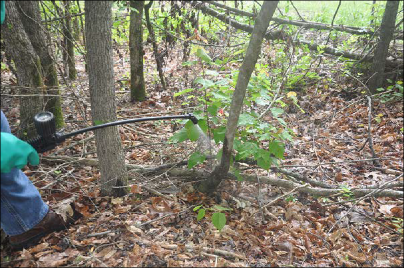
While injection typically provides excellent results, other methods and compounds may be justified at times due to species resistance and numbers. With high numbers of target small-diameter stems, injection may be too expensive. In addition to pine, some hardwood species are naturally resistant to imazapyr (e.g., elms, locusts, eastern redbud, wax myrtle). You will need to use a different compound in these situations. In either of these situations, a basal bark application may be possible. A basal bark application involves spraying the bottom 12–15 inches of the base of a stem with a solution of herbicide and penetrant oil. The recommended basal bark application is:
Garlon 4 mixed 25% vol/vol with penetrant oil
Apply to the circumference of the first 12–15 inches of stem base. Very limited efficacy after stem diameter reaches 4 inches.
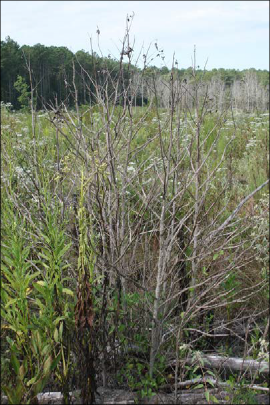
Directed spray applications
Directed spray applications can be used to remove unwanted stems in mixed pine-hardwood stands. The treatment involves spraying herbicide over the crown of targeted stems without applying it to the foliage of desirable stems. Foliar-active-only herbicides are used in this species mixture scenario, and applications are performed by hand. Subsequently, the technique is used only on stems less than 5 feet in height to minimize nontarget impact from wind drift. While several products can be used for directed spray applications in mixed pine-hardwood stands, the most cost-efficient and effective treatment option is:
5% vol/vol of a forestry-labeled glyphosate product + an appropriate surfactant
Conclusions
The push for species diversity is increasing some landowners’ desire to establish and/or manage mixed pine-hardwood stands. Planning herbicide applications in these systems is a more complicated process compared to that of pure pine or hardwood stands. However, increases in tree growth and survival, ability to manipulate stand composition, and improved affordability of commonly used herbicides make this type of management possible. You can reach your management goals through careful consideration of effective herbicides and appropriate application timing. Current herbicide options can help you reach your goals, but be cautious when using herbicides in any forest management effort.
Additional Reading
Dickens, D., Minouge, P., Clabo, D., & Moorhead, D. (2020). A guide to using imazapyr for chemical site preparation in southern pine plantation establishment. University of Georgia, Warnell School of Forestry & Natural Resources publication WSFR-20-95B. 8p.
Self, A. B. (2021). Herbicide options for loblolly pine management. Mississippi State University Extension. Publication 3233. 4p.
Self, A. B., & Ezell, A. (2020). Herbicide options for hardwood management. Mississippi State University Extension. Publication 2873. 8p.
Self, A. B. (2019). Tree injection for timber stand improvement. Mississippi State University Extension Service. Publication 2942. 8p.
Publication 3264 (POD-11-21)
By A. Brady Self, PhD, Associate Extension Professor.
The Mississippi State University Extension Service is working to ensure all web content is accessible to all users. If you need assistance accessing any of our content, please email the webteam or call 662-325-2262.


